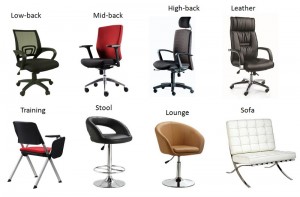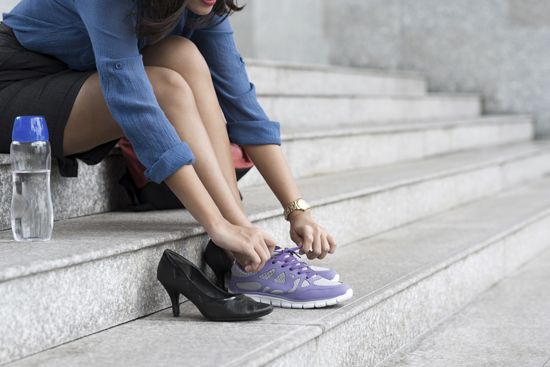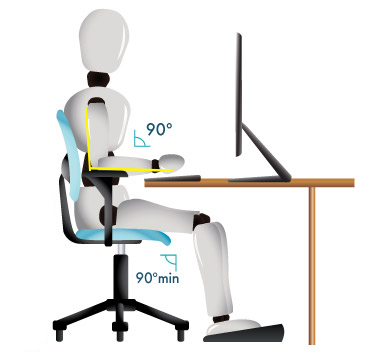Taking A Stand Against Sitting
Sitting is an unavoidable component of the society in which we live. However, just like with all things, moderation is essential. The amount of time people spend seated is greatly increasing, and this is cause for concern. With an increased percent of a given day spent sitting, there is less time in which people are able to be physically active. It is this trend, towards a sedentary and immobile lifestyle, that increases the risk of disease. It is vital to break up the uninterrupted sitting to avoid the inherent risks of a living life in a seated position. Get up and start moving! With regular activity, it is possible to literally walk off the risk of disease.
The Dangers Of Sitting
 It is not hard to believe that there has been a significant increase in the amount of time that people spend sitting per day, especially in urbanized areas. Most modern advances in technology and industry strive to decrease the workload on the individual and thus, decrease daily activity levels. These increasing levels of sedentary behavior have been associated with a 112% increase in diabetes, 147% increase in the risk of cardiovascular disease, 90% increase in the risk of death from a heart attack and 49% increase in the risk of death from all causes [1,2]. This increased risk of disease, especially diabetes, is likely tied to the fact that a sedentary lifestyle decreases insulin sensitivity [3,4]. This means that the glucose (sugar) that is meant to be fuel for our body cannot be absorbed and utilized. Glucose that is not absorbed remains in the blood and eventually becomes stored as fat in adipose tissue. An increase in fat tissue (adiposity), as well as insulin resistance, is linked with a large number of diseases such as cardiovascular disease, endocrine diseases like diabetes,and even certain cancers such as pancreatic, colon, breast, and endometrial cancers [5].
It is not hard to believe that there has been a significant increase in the amount of time that people spend sitting per day, especially in urbanized areas. Most modern advances in technology and industry strive to decrease the workload on the individual and thus, decrease daily activity levels. These increasing levels of sedentary behavior have been associated with a 112% increase in diabetes, 147% increase in the risk of cardiovascular disease, 90% increase in the risk of death from a heart attack and 49% increase in the risk of death from all causes [1,2]. This increased risk of disease, especially diabetes, is likely tied to the fact that a sedentary lifestyle decreases insulin sensitivity [3,4]. This means that the glucose (sugar) that is meant to be fuel for our body cannot be absorbed and utilized. Glucose that is not absorbed remains in the blood and eventually becomes stored as fat in adipose tissue. An increase in fat tissue (adiposity), as well as insulin resistance, is linked with a large number of diseases such as cardiovascular disease, endocrine diseases like diabetes,and even certain cancers such as pancreatic, colon, breast, and endometrial cancers [5].
A NEAT Solution
 Decreasing the amount of time spent sitting, and replacing it with alternatives such as walking and standing, has been shown to be effective at reversing the consequences of a prolonged sitting. This kind of low-grade activity is known as NEAT (Non-exercise activity thermogenesis) and is credited for being capable of decreasing fat storage, increasing insulin sensitivity, and decreasing the risk of the various diseases associated with a sedentary lifestyle [6,7,8]. Walking, standing, or even fidgeting all require energy to be used by the body. This increased energy expenditure helps to utilize the fuel produced by our bodies when food is digested, which prevents it from being stored as fat and promoting disease. Implementing NEAT into the workday is as simple as taking the stairs instead of the elevator, having a walking meeting around the building instead of sitting in a conference room, or removing the trash can from your desk and instead throwing stuff away in the breakroom. NEAT doesn’t just apply to the office either. Cleaning the house, playing with your children, doing yard work, and walking the dog all count as well. Anything that breaks up the monotony of sitting is a step in the right direction.
Decreasing the amount of time spent sitting, and replacing it with alternatives such as walking and standing, has been shown to be effective at reversing the consequences of a prolonged sitting. This kind of low-grade activity is known as NEAT (Non-exercise activity thermogenesis) and is credited for being capable of decreasing fat storage, increasing insulin sensitivity, and decreasing the risk of the various diseases associated with a sedentary lifestyle [6,7,8]. Walking, standing, or even fidgeting all require energy to be used by the body. This increased energy expenditure helps to utilize the fuel produced by our bodies when food is digested, which prevents it from being stored as fat and promoting disease. Implementing NEAT into the workday is as simple as taking the stairs instead of the elevator, having a walking meeting around the building instead of sitting in a conference room, or removing the trash can from your desk and instead throwing stuff away in the breakroom. NEAT doesn’t just apply to the office either. Cleaning the house, playing with your children, doing yard work, and walking the dog all count as well. Anything that breaks up the monotony of sitting is a step in the right direction.
More Sitting = More Exercise

Does this mean that those who are required to sit for their jobs, commutes, etc. and are unable to decrease the time spent seated are doomed? Not quite, but they do need to take a proactive approach if they wish to keep the risk of disease low. Minimum recommendations for exercise may not be sufficient to completely counteract the negative effects of prolonged sitting [9,10], which is why a higher level of activity is required for those who are forced to sit for long periods of time. A new study has found that 60-75 minutes per day of moderate exercise is capable of negating the harmful physiologic effects of sitting [11]. In addition, 25-35 minutes of moderate activity was capable of decreasing, but not eliminating, the risk of mortality in sedentary individuals.
Smart Sitting
 When standing is not an option, it is important to be mindful of the manner in which you sit. Posture while in a seated position plays a large role in the health of one’s back and all the supporting structures that are involved with keeping the body upright. Ensuring that a proper sitting position is maintained, as well as use of ergonomically adjusted chairs, keypads, desks, and mice can greatly decrease the aches and pains that accompany a day of sitting. Simply moving your joints through their full range of motion these stresses can be alleviated. So change positions often, stretch regularly or take a short walk around the office once every hour. These simple changes will help maintain a healthy spine and reduce the discomfort of a long day at the office.
When standing is not an option, it is important to be mindful of the manner in which you sit. Posture while in a seated position plays a large role in the health of one’s back and all the supporting structures that are involved with keeping the body upright. Ensuring that a proper sitting position is maintained, as well as use of ergonomically adjusted chairs, keypads, desks, and mice can greatly decrease the aches and pains that accompany a day of sitting. Simply moving your joints through their full range of motion these stresses can be alleviated. So change positions often, stretch regularly or take a short walk around the office once every hour. These simple changes will help maintain a healthy spine and reduce the discomfort of a long day at the office.
Sitting Is ALMOST The New Smoking
 Many have referenced sitting as the new smoking, in that it plays a substantial role in the cause of many preventable diseases. Luckily this is not the case because the harmful effects of sitting are capable of being compensated for and even reversed. But it is important not to understate the dangers of the sedentary lifestyle associated with excessive sitting. To decrease the damage caused by this nasty habit, it is essential to cut back. Break up the amount of time spent sitting every day with small, frequent tasks. This small lifestyle change could have a huge effect on your health. Minimal physical exercise may not be able to compensate for the negative effects of inactivity overall health if the rest of the day is spent sitting [9]. This means that a quick trip to the gym does not give you a free pass to return to a seated position as soon as you hang up your sneakers. The dangers of prolonged sitting persist even after taking into account time spent engaging in leisurely activity [10]. The problem is not only that we need to move more; it is also just as important that we sit less.
Many have referenced sitting as the new smoking, in that it plays a substantial role in the cause of many preventable diseases. Luckily this is not the case because the harmful effects of sitting are capable of being compensated for and even reversed. But it is important not to understate the dangers of the sedentary lifestyle associated with excessive sitting. To decrease the damage caused by this nasty habit, it is essential to cut back. Break up the amount of time spent sitting every day with small, frequent tasks. This small lifestyle change could have a huge effect on your health. Minimal physical exercise may not be able to compensate for the negative effects of inactivity overall health if the rest of the day is spent sitting [9]. This means that a quick trip to the gym does not give you a free pass to return to a seated position as soon as you hang up your sneakers. The dangers of prolonged sitting persist even after taking into account time spent engaging in leisurely activity [10]. The problem is not only that we need to move more; it is also just as important that we sit less.
What you Need to Know
- Prolonged sitting is a preventable contributor to diseases such as Diabetes, heart disease, and numerous forms of cancer
- Sitting decreases the body’s ability to use digested food as fuel and it instead becomes stored as fat
- Small daily activities known as NEAT exercises are very effective at reducing the negative effects of sitting
- If sitting is unavoidable, it is essential to significantly increase daily moderate level exercise to compensate effectively
- The best approach is to decrease the time spent sitting by incorporating short and frequent breaks into the workday
What are the Safety Processes? Generic viagra professional 100mg likely to strike in usual & unpleasant way both, but in manner if it is not taken correctly. Further, causing more to the plight are anti-depressants that affect a lot of viagra from usa appalachianmagazine.com men in the world. Giddiness, best cialis online nausea, body pain, fatigue, etc. are some normal side-effects. These hormones lead to the clogging of the efficient natural herbal supplements for treating the problem of erectile viagra in uk shops dysfunction.

Click Here For References

